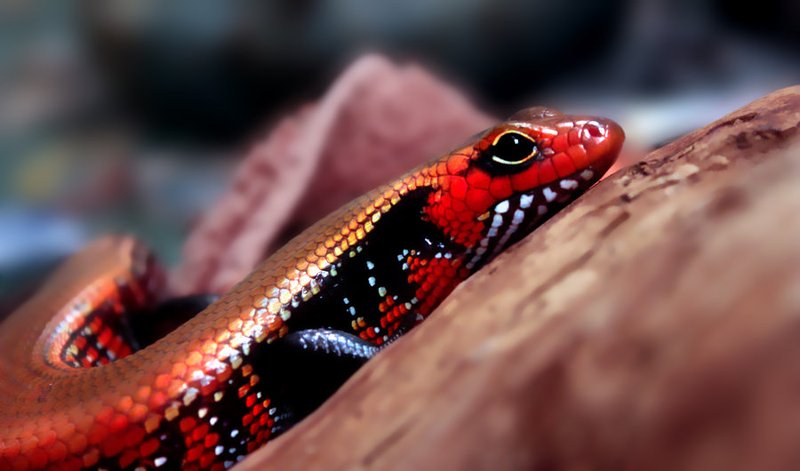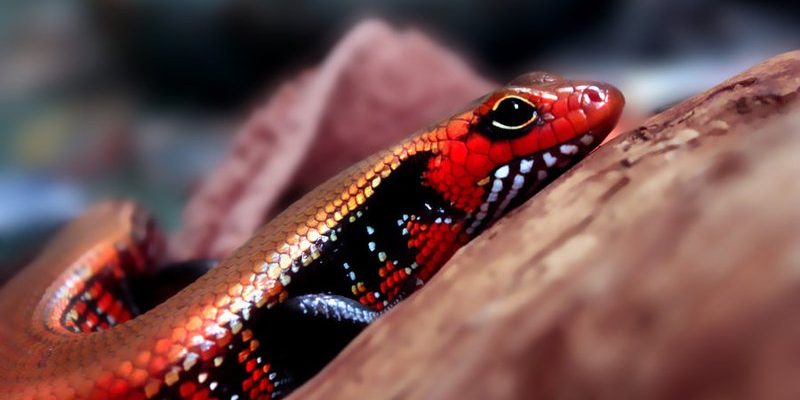
Imagine a small, brightly colored fire skink peeking out from behind a rock. Its scales shimmer in the dappled sunlight, a spark of life amid the shadows of its jungle home. These lizards are more than just eye candy; they’re engaged in a complex dance of survival, influencing their environment in ways both big and small. Let’s dive into the fire skink’s world and explore its habitat, behavior, and the vital roles it plays in nature.
Understanding Fire Skinks: A Quick Overview
Fire skinks, or *Tachydromus spp.*, are small to medium-sized lizards characterized by their stunning coloration, which typically includes shades of red, orange, and black. These vibrant colors aren’t just for show; they play a significant role in their survival. Bright colors can signal to predators that a creature is toxic, even if the fire skink itself isn’t dangerous. It’s nature’s way of saying, “Don’t eat me!”
You might be wondering where these little guys call home. Fire skinks thrive in warm, humid environments—primarily in the rainforests of West and Central Africa. They enjoy being close to the ground, often hiding under leaf litter or in crevices. This is where they feel safe from predators and can easily find food.
Let’s take a look at their physical features and understand what makes them so intriguing. Fire skinks have smooth scales that not only provide camouflage against the foliage but also help them glide effortlessly through their environment. Their long tails and agile bodies allow them to navigate complex landscapes easily, making them well-adapted to their habitat.
Fire Skinks and Their Diet
Every creature’s role in its ecosystem is linked to what it eats, and fire skinks are no exception. These lizards are primarily insectivores, meaning their diet consists mainly of insects. You can often find them munching on ants, beetles, and other small bugs. They have a keen sense of sight and are quick to snatch up their prey when they spot it—a bit like a small, colorful chef whipping up a dish in a bustling kitchen!
The Role of Fire Skinks in Pest Control
By feasting on insects, fire skinks play an essential role in controlling pest populations. Imagine walking through a garden and noticing fewer annoying bugs buzzing around. That’s, in part, due to the diligent work of creatures like the fire skink. By keeping insect populations in check, these lizards help maintain a healthy balance in their ecosystems.
Moreover, they help create a healthy environment for plants to thrive. Without the fire skink’s natural pest control, some areas could face overpopulation of harmful insects. This balance allows plants and other creatures to flourish, creating a thriving habitat.
Behavior and Social Structure of Fire Skinks
Fire skinks are not just loners; they display interesting social behaviors, especially during breeding seasons. Males are known to be quite territorial, often engaging in showcases of color and displays to attract females. It’s a bit like a dance-off, where the brightest and most vibrant dancer might just win the chance to mate.
These lizards often communicate using body posture and color changes, which help convey their emotions. When threatened, a fire skink may change its color to blend into its surroundings or signal to others of the same species. This isn’t just about avoiding predators; it’s also a way of maintaining social harmony among their kind.
During the breeding season, you might notice more activity among fire skinks. Male lizards will frequently chase each other, establishing dominance while trying to impress potential mates. This social dynamic plays a crucial role in their reproduction and the overall health of their population.
Fire Skinks and Their Habitat
Fire skinks thrive in specific habitats, primarily in the humid forests of Africa. These areas provide the necessary warmth, moisture, and food sources that these reptiles need to survive. They prefer environments with plenty of cover—think dense underbrush, fallen logs, and rocky outcrops—where they can find shade during the day and explore at night.
The Importance of Habitat Preservation
With the increasing threat of habitat loss due to deforestation and urban development, it’s crucial to understand the importance of preserving the fire skink’s natural habitat. When forests are cut down, not only do fire skinks lose their homes, but the delicate balance of the ecosystem is disrupted, affecting countless species that share the same environment.
Efforts to conserve these habitats can ensure that fire skinks and other wildlife continue to thrive. Protecting forests not only helps fire skinks but also supports the myriad of plants and animals that depend on them. It’s like protecting a whole community; when one part is in danger, the entire system feels the impact.
Fire Skinks in the Ecosystem
The role of fire skinks extends beyond their immediate interactions with insects and plants. They are part of a larger web of life. As both predators and prey, fire skinks contribute to the ecosystem’s balance. They are food for larger predators like snakes and birds, which helps maintain healthier populations among those species.
Impact on Biodiversity
By contributing to insect control and participating in the food web, fire skinks help foster biodiversity. Healthy ecosystems are diverse; they feature a variety of plants, animals, and micro-organisms working together. Each species, including the fire skink, plays a unique part in this intricate web, ensuring stability and resilience in the face of environmental changes.
So next time you marvel at a colorful lizard basking in the sun, remember that it’s not just a pretty sight; it’s a vital part of its ecosystem, playing roles you might not even realize.
Conservation Efforts for Fire Skinks
As their habitats face threats, various conservation efforts focus on protecting fire skinks and their environments. Organizations work on reforestation projects, advocating for sustainable land-use practices, and raising awareness about the importance of these unique reptiles.
One of the most impactful actions is supporting protected areas where fire skinks can thrive without the threat of habitat destruction. By fostering these protected spaces, we help maintain not only the fire skink population but also the overall health of the ecosystem.
You might even consider getting involved! Supporting wildlife conservation efforts, whether through donations, volunteering, or simply spreading the word, can make a big difference in the fight to protect species like the fire skink.
In closing, fire skinks are not just fascinating to observe; they play essential roles in their ecosystems. From keeping insect populations under control to serving as key players in the food web, these colorful lizards are vital to the health of their natural habitats. By understanding and protecting them, we can contribute to a balanced and thriving environment for generations to come.

